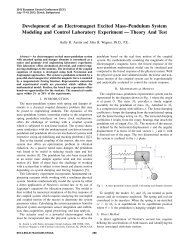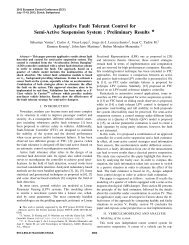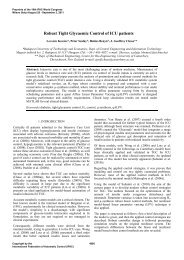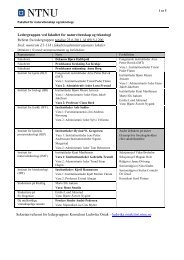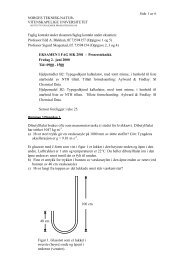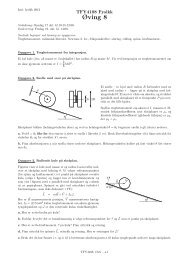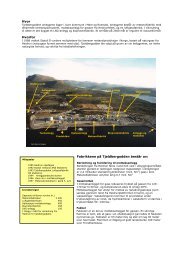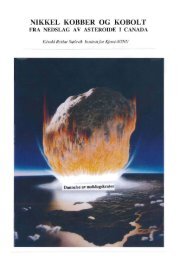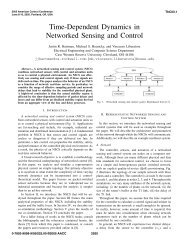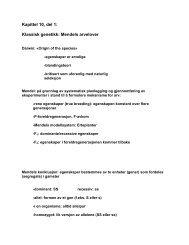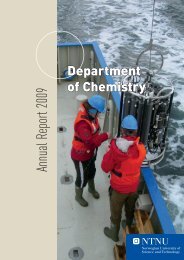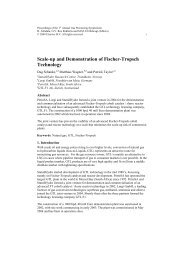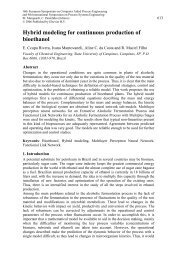CPC VI -- Chemical Process Control VI
CPC VI -- Chemical Process Control VI
CPC VI -- Chemical Process Control VI
You also want an ePaper? Increase the reach of your titles
YUMPU automatically turns print PDFs into web optimized ePapers that Google loves.
Nonlinear Model Reduction for Optimization Based <strong>Control</strong> of Transient <strong>Chemical</strong> <strong>Process</strong>es 17<br />
surprising that modeling and the proper validation of<br />
the resulting models is (and will be for a long time) the<br />
major bottleneck in introducing model-based operation<br />
support systems into industrial application.<br />
Recently, Foss et al. (1998) undertook an industrial<br />
field study to identify current industrial practice in process<br />
modeling. They identified the same major steps<br />
organized nearly the same way in a work process in all<br />
the companies included in the study, if only a coarse task<br />
granularity is considered. There seem to be no generally<br />
practiced patterns on the subtask level. A first analysis<br />
of the modeling work process on a detailed level has<br />
been attempted recently (Marquardt, 1995; Lohmann<br />
and Marquardt, 1996; Lohmann, 1998) in the context of<br />
work process centered computer-aided modeling support<br />
systems (Jarke and Marquardt, 1996; Bogusch et al.,<br />
2001). The approach pursued in these studies is promising<br />
but does not yet address the requirements of optimization<br />
based control sufficiently. More emphasis has to<br />
be put on model transformations (including model order<br />
reduction and simplification), model structure discrimination<br />
and parameter identification as well as closed-loop<br />
model validation in the future.<br />
We are far from a recommended work process which<br />
would lead us to a reasonable set of models for a decomposed<br />
optimization based operations support system at<br />
minimal cost. This section presents the major modeling<br />
steps on a coarse granular task level to guide the development<br />
of more elaborate modeling work processes (see<br />
Foss et al., 1998, for details) and to put model reduction<br />
and model application as discussed in the remainder of<br />
the paper into perspective.<br />
(a) Requirements analysis: A precise problem formulation<br />
is necessary but often omitted in process modeling<br />
since most of the requirements are still vague.<br />
As in any design activity these requirements have<br />
to evolve with the model during the modeling process.<br />
Major issues are the purpose of modeling and<br />
the intended application of the model, the quantities<br />
to be computed from the model, their dependency<br />
on time and non-time coordinates, the accuracy to<br />
be attained, the available resources for model construction<br />
and the available computational resources<br />
for model interpretation.<br />
(b) Abstraction of the process: The boundaries of the<br />
process under consideration are specified by stating<br />
all external connections to the process’ environment<br />
first. Subsequently, the process is decomposed<br />
hierarchically into more and more refined interconnected<br />
model objects until a desired level of resolution<br />
is reached. The properties of the model objects<br />
are described in detail. The information collected<br />
comprises an informal descriptive representation of<br />
the model. The extensive quantities to be balanced,<br />
the assumptions on the physico-chemical phenom-<br />
ena and the level of detail to be considered are for<br />
example part of this description. Canonical model<br />
objects and a recommended procedure have been<br />
defined to guide this abstraction process (e.g. Marquardt,<br />
1995).<br />
(c) Formulation of model equations: For every model<br />
object, the descriptive model of step (b) is cast<br />
into a set of model equations to precisely define<br />
the model object’s dynamics. The informal descriptive<br />
model is converted into a formal mathematical<br />
model. First, the balance equations are determined<br />
accounting for the desired spatial resolution. The<br />
process quantities occurring in the balance equations<br />
are classified as states, parameters or state<br />
functions. Parameters are fixed together with an<br />
uncertainty interval. State functions are refined by<br />
additional constitutive equations. Appropriate initial<br />
and boundary conditions are specified. Simultaneously,<br />
a consistency check of physical dimensions<br />
and units, an analysis of the remaining degrees of<br />
freedom or of the differential index can be carried<br />
out (Bogusch et al., 2001).<br />
The resulting process model comprises partial differential<br />
equations to cope with spatially distributed<br />
model objects, integro-differential-equations to represent<br />
particulate model objects by population balances,<br />
as well as differential-algebraic equations to<br />
describe spatially averaged (well-mixed) model objects.<br />
Often, the models are in addition of a hybrid<br />
discrete-continuous nature (Barton and Pantelides,<br />
1994) to represent physical state events (such as a<br />
phase change) or discrete control action (such as a<br />
switching controller).<br />
(d) Aggregation of model equations: The equations of<br />
the whole process model are deduced by an aggregation<br />
of those of every model object. This aggregation<br />
process follows the hierarchical structure introduced<br />
during the abstraction in step (b). Additional<br />
constraints due to the aggregation may be<br />
introduced. Again, the model is checked for its index<br />
as well as for a proper specification of degrees<br />
of freedom and initial conditions. The resulting<br />
model may be very large-scale and may comprise of<br />
some hundred thousand equations if plant-wide or<br />
even site-wide optimization is envisaged. The model<br />
structure may be exploited later to accomplish horizontal<br />
decomposition (cf. Figure 2).<br />
(e) Model transformation: Usually, the model equations<br />
are not solved as derived during the modeling process.<br />
Instead, the model equations are reformulated<br />
with different objectives. For example, reformulation<br />
or even model reduction are performed to reduce<br />
the computational complexity or the index in<br />
case of high index models.



